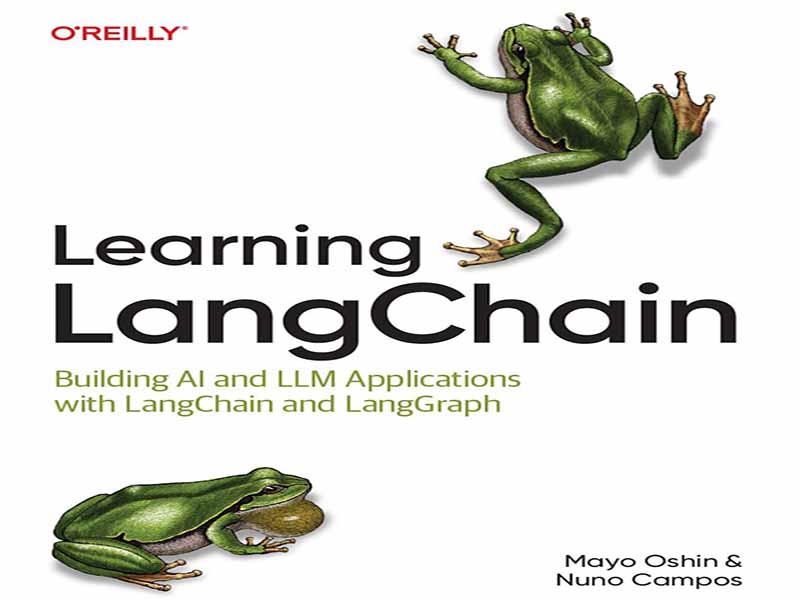- عنوان کتاب: Learning LangChain -Building AI and LLM Applications with LangChain and LangGraph
- نویسنده: Mayo Oshin Nuno Campos
- حوزه: مدل زبانی
- سال انتشار: 2025
- تعداد صفحه: 297
- زبان اصلی: انگلیسی
- نوع فایل: pdf
- حجم فایل: 9.33 مگابایت
در 30 نوامبر 2022، شرکت OpenAI مستقر در سانفرانسیسکو، ChatGPT را به صورت عمومی منتشر کرد – چتبات هوش مصنوعی پرطرفداری که میتواند محتوا تولید کند، به سوالات پاسخ دهد و مانند یک انسان مشکلات را حل کند. ظرف دو ماه از زمان راهاندازی، ChatGPT بیش از 100 میلیون کاربر فعال ماهانه را جذب کرد که سریعترین نرخ پذیرش یک برنامه کاربردی فناوری جدید مصرفی (تا کنون) است. ChatGPT یک تجربه چتبات است که توسط یک نسخه دستورالعمل و گفتگو محور از خانواده مدلهای زبانی بزرگ (LLM) GPT-3.5 OpenAI پشتیبانی میشود. به زودی به تعاریف این مفاهیم خواهیم پرداخت. ساخت برنامههای LLM با یا بدون LangChain نیاز به استفاده از LLM دارد. در این کتاب، ما از API OpenAI به عنوان ارائهدهنده LLM که در مثالهای کد استفاده میکنیم، استفاده خواهیم کرد (قیمتگذاری روی پلتفرم آن ذکر شده است). یکی از مزایای کار با LangChain این است که میتوانید با استفاده از OpenAI یا ارائهدهندگان LLM تجاری یا متنباز جایگزین، همه این مثالها را دنبال کنید. سه ماه بعد، OpenAI API ChatGPT را منتشر کرد و به توسعهدهندگان امکان دسترسی به قابلیتهای چت و تبدیل گفتار به متن را داد. این امر باعث آغاز تعداد بیشماری از برنامههای جدید و پیشرفتهای فنی تحت عنوان گسترده هوش مصنوعی مولد شد. قبل از اینکه هوش مصنوعی مولد و LLMها را تعریف کنیم، بیایید به مفهوم یادگیری ماشین (ML) بپردازیم. برخی از الگوریتمهای کامپیوتری (یک دستور العمل تکرارپذیر برای دستیابی به یک کار از پیش تعریف شده، مانند مرتب کردن یک دسته کارت را تصور کنید) مستقیماً توسط یک مهندس نرمافزار نوشته میشوند. در عوض، سایر الگوریتمهای کامپیوتری از انبوهی از نمونههای آموزشی آموخته میشوند – وظیفه مهندس نرمافزار از نوشتن خود الگوریتم به نوشتن منطق آموزشی که الگوریتم را ایجاد میکند، تغییر میکند. توجه زیادی در حوزه یادگیری ماشین به توسعه الگوریتمهایی برای پیشبینی هر تعداد چیز، از آب و هوای فردا گرفته تا کارآمدترین مسیر تحویل برای یک راننده آمازون، معطوف شد.
On November 30, 2022, San Francisco–based firm OpenAI publicly released ChatGPT—the viral AI chatbot that can generate content, answer questions, and solve problems like a human. Within two months of its launch, ChatGPT attracted over 100 million monthly active users, the fastest adoption rate of a new consumer technology application (so far). ChatGPT is a chatbot experience powered by an instruction and dialogue-tuned version of OpenAI’s GPT-3.5 family of large language models (LLMs). We’ll get to definitions of these concepts very shortly. Building LLM applications with or without LangChain requires the use of an LLM. In this book we will be making use of the OpenAI API as the LLM provider we use in the code examples (pricing is listed on its platform). One of the benefits of working with LangChain is that you can follow along with all of these examples using either OpenAI or alternative commercial or open source LLM providers. Three months later, OpenAI released the ChatGPT API, giving developers access to the chat and speech-to-text capabilities. This kickstarted an uncountable number of new applications and technical developments under the loose umbrella term of generative AI. Before we define generative AI and LLMs, let’s touch on the concept of machine learning (ML). Some computer algorithms (imagine a repeatable recipe for achievement of some predefined task, such as sorting a deck of cards) are directly written by a software engineer. Other computer algorithms are instead learned from vast amounts of training examples—the job of the software engineer shifts from writing the algorithm itself to writing the training logic that creates the algorithm. A lot of attention in the ML field went into developing algorithms for predicting any number of things, from tomorrow’s weather to the most efficient delivery route for an Amazon driver.
این کتاب را میتوانید از لینک زیر بصورت رایگان دانلود کنید:
Download: Learning LangChain




































نظرات کاربران